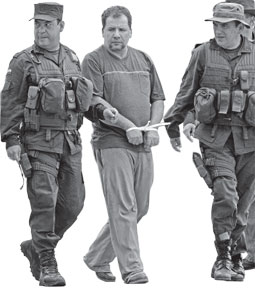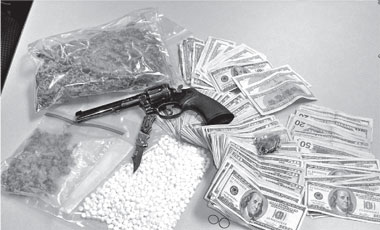|
Today is International Day against Drug Abuse and
Illicit Trafficking:
Community action vital to counter drug menace
By Pramod DE SILVA
Illicit drugs are a threat to society, especially to the younger
generation. Illegal narcotics with a street value of millions of dollars
are smuggled across borders to feed the drugs trade the world over. Drug
addiction has become a major social problem in most countries including
Sri Lanka. More attention has to be focused on this grave problem at
international level.
 |
|
Afghan forces
destroying opium fields |
It is with this aim in mind that the United Nations in 1987
designated June 26 (today) as the International Day against Drug Abuse
and Illicit Trafficking.
The day raises awareness of the major problem that illicit drugs
represent to society at national and global levels. It has been held
annually since 1988 on June 26, a date chosen to commemorate Lin Zexu's
dismantling of the opium trade in Humen, Guandong, just before the First
Opium War in China. The observance was instituted by a UN General
Assembly resolution on December 7, 1987.
Following the resolution, the years 1991 to 2000 were heralded as the
United Nations Decade Against Drug Abuse. In 1998 the UN General
Assembly adopted a political declaration to address the global drug
problem. The declaration expresses UN members' commitment to fighting
the problem.
The UN Office on Drugs and Crime (UNODC) has, over the years, been
actively involved in launching these campaigns to mobilise support for
drug control. According to the UNODC, nearly 200 million people are
using illicit drugs such as cocaine, cannabis, hallucinogens, opiates
and sedative hypnotics worldwide.
UN report
The UN's World Drug Report, unveiled on Thursday, puts the value of
the illegal drug trade at over US$325 billion a year. Launched
simultaneously in London and New York, this annual report highlights
developments across the global drug market to explain the factors that
drive the world's consumption, production and trafficking of illicit
drugs. (Drug trafficking is a global illicit trade involving the
cultivation, manufacture, distribution and sale of substances which are
subject to drug prohibition laws.)
This year's theme for the world anti-drugs day, 'Global action for
healthy communities without drugs', is meant to reinforce the role that
communities play in addressing the drugs challenge. Events will be held
all over the world, from Australia to Zimbabwe, to look at the effects
of drugs in local communities and how we can stop them.
From the dangerous effects of heroin to the prevention of HIV/AIDS
and needle sharing, there will be information available to get educated
and join the fight against drug abuse.
 |
|
A Colombian drug lord
under arrest |
The day's theme aims at highlighting the fact that successful
approaches in drug use prevention and treatment involve families,
schools, and communities to build on protective factors, and it further
calls upon communities to take action against drugs.
It is important to recognise what community groups are doing to
reduce drug abuse and how they can work together to tackle drugs and the
problems that drugs create in the society.
Global action
It also stresses the need for 'global action', since the drugs cancer
has now grown globally. Individual countries alone cannot fight the
sophisticated drug smuggling operatives and networks - it is an
operation that requires international cooperation.
Community and grassroots initiatives have a crucial role to play in
preventing drug use, UN Office on Drugs and Crimes Executive Director
Yury Fedotov told a recent meeting.
"Drug control is not all about governments and law enforcement; it is
also about families, teachers, youth leaders and mentors. Prevention
starts with a community that cares about the vulnerable. Think globally,
act locally", he said, stressing that community-level action must be
stepped up.
Children and youth comprise the social group that is most vulnerable
to drugs. The message on drugs has to be conveyed to children first at
home by parents and then at school by teachers. Religious leaders and
places of worship too have a major role to play in moulding a younger
generation that abhors drugs.
The media has an obligation to inform the society about the dangers
of narcotics and other substances which can be abused. Sri Lanka also
has a number of Governmental and Non-Governmental organisations which
educate the public effectively on substance abuse.
The world community must intensify the 'war on drugs', just as it
intensified the war on terrorism. On a global level, it has emerged that
drug traffickers use increasingly sophisticated methods to smuggle
drugs.
"There has been a repositioning of the drug routes and the drug
traffickers have much more sophisticated means and they are using more
routes," a UN official explained recently.
There is evidence to suggest cartels have used submarines, as they
have done off the South American and Caribbean coasts. "We are not
talking about military vessels, but rather smaller ones which can be
bought freely in the international market by anybody who has a couple of
million dollars to spare," he said.
Drug cartels, which were earlier confined to South America, had
started to emerge all over the world, especially in Asia and Africa.
They stayed one step ahead of transnational crime units, according to UN
researchers.
The drug trade is flourishing despite crackdowns by governments. For
example, at current levels, world heroin consumption (340 tons) and
seizures represent an annual flow of 430-450 tons of heroin into the
global heroin market.
Of that total, opium from Myanmar and Laos yields some 50 tons, while
the rest, some 380 tons of heroin and morphine, is produced exclusively
from Afghan opium. While approximately five tons are consumed and seized
in Afghanistan, the remaining bulk of 375 tons is trafficked worldwide
via routes flowing into and through the countries neighbouring
Afghanistan.
Record level
In 2008, global heroin seizures reached a record level of 73.7 metric
tons. Most of the heroin was seized in the Near and Middle East and
South-West Asia (39 percent of the global total), South-East Europe (24
percent) and Western and Central Europe (10 percent).
 |
|
Violence related to
drug trafficking is increasing |
As for cocaine, it is used by some 16 to 17 million people worldwide,
similar to the number of global opiate users. North America accounted
for more than 40 percent of global cocaine consumption (the total was
estimated at around 470 tons), while the 27 European Union and four
European Free Trade Association countries accounted for more than a
quarter of the total consumption.
These two regions account for more than 80 percent of the total value
of the global cocaine market, estimated at $88 billion. These are
statistics pertaining to just two illicit drugs that illustrate the
scale of the problem faced by law enforcement authorities.
Urgent action has to be taken to prevent the younger generation from
falling prey to the evils of illicit drugs. That must be the cornerstone
of any governmental and international action against the illegal drugs
trade. The authorities everywhere must pursue the drug lords who spread
this cancer in society.
Their victims - those who are addicted to drugs - have to be fully
rehabilitated while taking all possible steps to ward off others from
the drugs menace.
The world anti-drug day that falls today is an ideal opportunity to
reflect on these issues and take action at community and government
level to create a righteous society free of illegal narcotics. |

